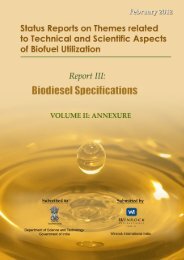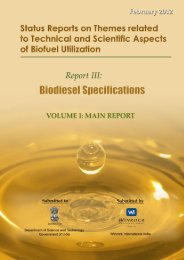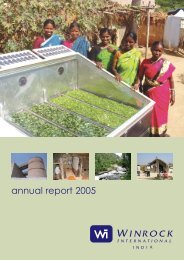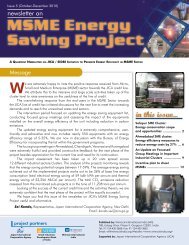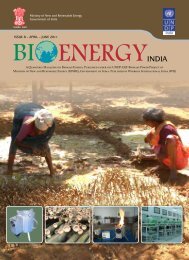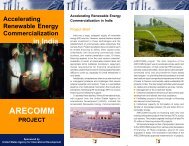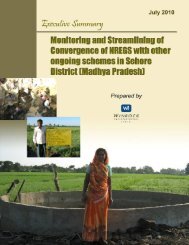ACT Apr-Jun10.p65 - Petroleum Conservation Research Association
ACT Apr-Jun10.p65 - Petroleum Conservation Research Association
ACT Apr-Jun10.p65 - Petroleum Conservation Research Association
You also want an ePaper? Increase the reach of your titles
YUMPU automatically turns print PDFs into web optimized ePapers that Google loves.
I N F O R M A T I O N C A P S U L E<br />
Economics of Energy Efficiency<br />
There are enormous economic benefits<br />
that can be gained by increasing our<br />
nation’s energy efficiency. Therefore,<br />
investing in efficiency measures is the<br />
most immediate and effective way to lower<br />
energy demand, reduce carbon emissions,<br />
and save households and businesses’<br />
money. According to some experts, the<br />
potential for savings throughout all<br />
sectors of the Indian economy is<br />
estimated to be of the order of<br />
90 million tonnes oil equivalent.<br />
Specialists also claim that the current<br />
energy policy does not take full advantage<br />
of savings offered by promoting energy<br />
efficiency in transportation, buildings, and<br />
industrial sectors which can actually make<br />
a significantly large contribution toward<br />
stabilizing energy prices, therfore<br />
strengthening the robustness of the Indian<br />
economy. It’s for all these reasons that<br />
efficiency should be viewed as a hidden<br />
energy reserve as well as an economic<br />
opportunity.<br />
From an economic perspective, energy<br />
efficiency choices fundamentally involve<br />
investment decisions that trade off higher<br />
initial capital costs and uncertain lower<br />
future energy operating costs. In the<br />
simplest case, the initial cost is the<br />
difference between the purchase and<br />
installation cost of a relatively energyefficient<br />
product and the cost of an<br />
otherwise equivalent product that provides<br />
the same services but uses more energy.<br />
As far as doing away with less efficient<br />
equipments is concerned, the cost is much<br />
higher and therefore the decision of<br />
whether to make the energy-efficient<br />
investment requires weighing the initial<br />
capital cost against the expected future<br />
savings. Assessing the future savings<br />
requires forming expectations of future<br />
energy prices, changes in other operating<br />
costs related to the energy use (e.g.,<br />
pollution charges, carbon credits, PF<br />
penalty, contract load reduction rebate<br />
etc), intensity of use of the product, and<br />
equipment lifetime. And finally deduction<br />
of the future cash flows to initial<br />
investment cost reveals the viability of the<br />
investment.<br />
As described above, the relative price will<br />
finally depend on the capital cost of<br />
efficiency improvements, the discount<br />
rate, expected energy prices, equipment<br />
utilization, and decision time horizon.<br />
This framework applies at the household<br />
level as well as at a broad sectoral or multisectoral<br />
level where energy and capital<br />
are used to produce energy.<br />
Courtesy: VK Srivastava, Additional Director,<br />
PCRA<br />
8<br />
active conservation techniques




